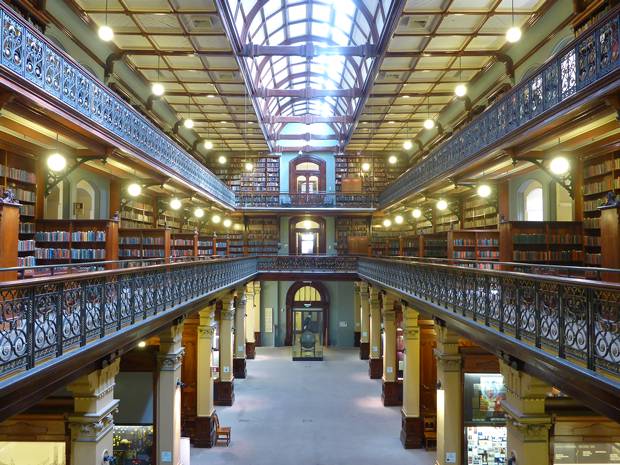An Open Lattice Pie that is Adelaide
We hadn’t yet bought our meagre food shop for the few days we would be in Adelaide so we emerged from our comfy room the next morning onto Waymouth Street and headed for the nearest breakfast bar. I wondered if they meant Weymouth as many streets are named after their UK counterpart.
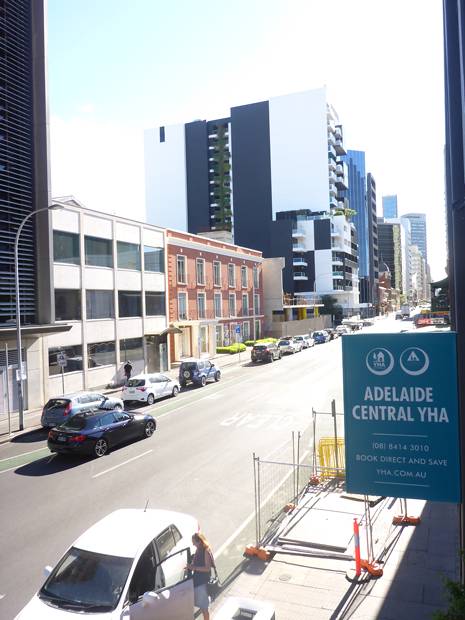

As Adelaide is tucked underneath Australia on any map and since we are termed as ‘down under’ by folk back home it seems appropriate that I write the next couple of blogs from an upside down perspective. So although we visited three venues next and explored what they had to deliver on the inside I will not go there first, instead I am going to tell you about the street architecture which has something we have not found in any Australian City so far.
Do you remember when we toured from Whangarei south to Napier, Hastings and Tauranga and how the preservation of the art deco architecture in Hastings with all its user friendliness struck us as more determined and dedicated than in Napier where some ugly modernist buildings had appeared on demolished art deco building sites?
Then in Canberra the design was infused with modernist ideas in line with the forward thinking dynamism of a new capital, like Italian Futurism. Well Adelaide has managed both and kept the main streets a truly pleasant and attractive place for pedestrians and shoppers to enjoy.
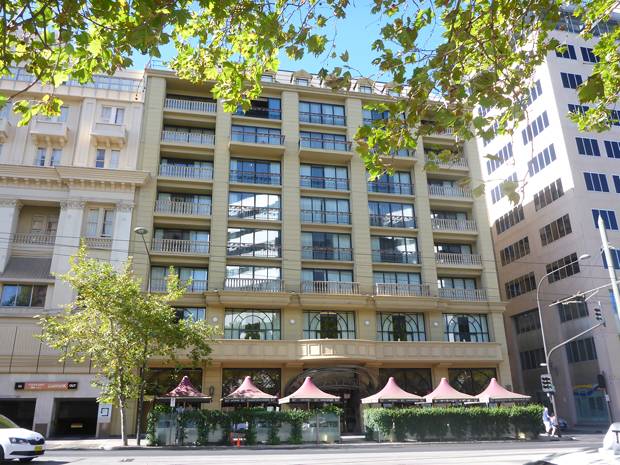
From the gallery of photos you will see the old buildings sitting comfortably in between modern buildings which themselves pay tribute to numerous schools of architecture from the past and looking to the future.
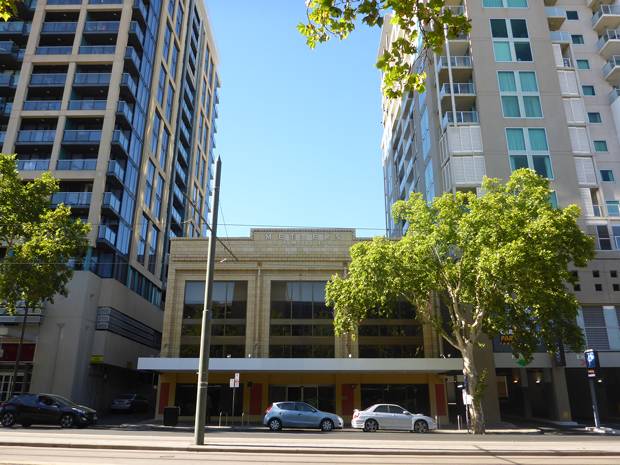
By using pink stone which is warm and is enhanced by the sun’s rays and creating pilasters (flat pillars) to hide steel girders, pediments and arches of the classical era on modern buildings, little Juliette balconies, the corners cut off the high rise hotel to soften the hard angles and more, a harmonious living space is created that accommodates modern demands for business and lifestyle with efficiency and beauty.
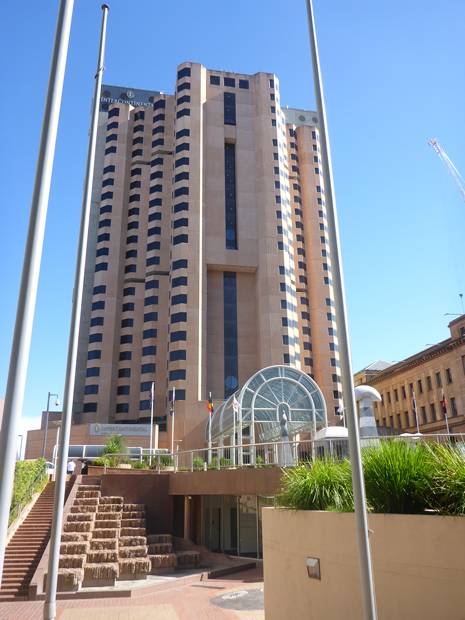
We started out along North Terrace, the main, long and most magnificent street in the town, Broke Back and Crook Foot slowed down by infirmity and awe at the wide vistas, generous pavements and shiny trams all framed with the clean majestic architectural mix.
The old Government House with its Romanesque arches sits not far from and on the same level as the beautiful Georgian new government house. Rob held the camera high to get the photo over the security wall.
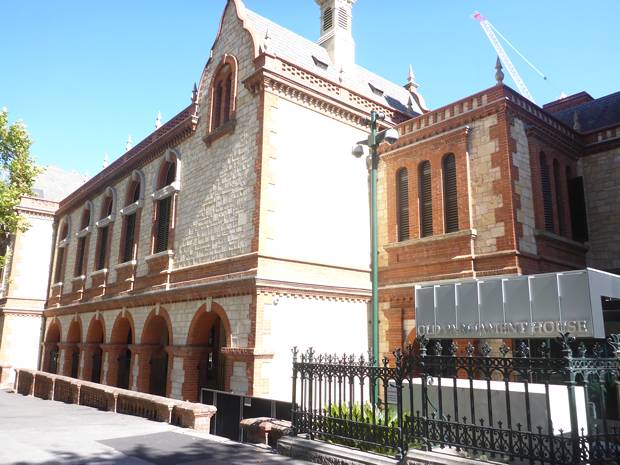
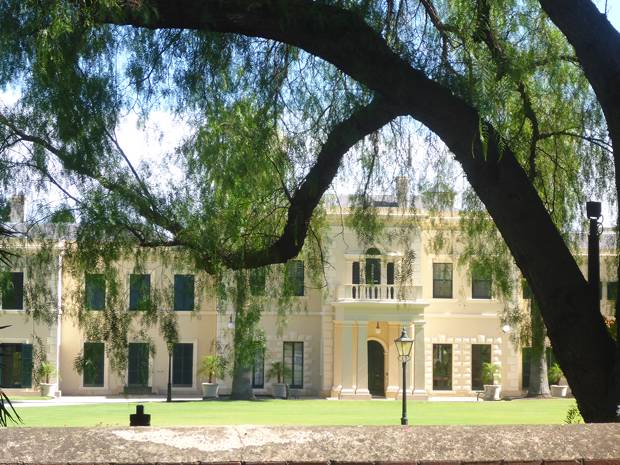
North Terrace continues on past the University and Cultural Precinct towards the Botanical Gardens, onwards to the suburb of Hackney and the eastern hills we could see in the distance, but that would be for another day. Looking at a map of Adelaide the City centre is a lattice of roads laid parallel and at right angles to eachother surrounded by the green of parks, golf courses, a cemetery and the Oval Cricket Ground skirted by the River Torrens; so similar in content to London and an apple pie on the map.
People from all over Australia have finished their life’s work and come to retire in Adelaide and I can see why, no cyclones, no crocs, a pleasant climate (usually, they have had extreme weather recently like everywhere else) and a beautiful, uncrowded city.
We arrived at the trilogy of the State Library of South Australia, the South Australian Museum and the Art Gallery of South Australia and prepared to launch ourselves, tentatively in to explore their wonderful treasures.
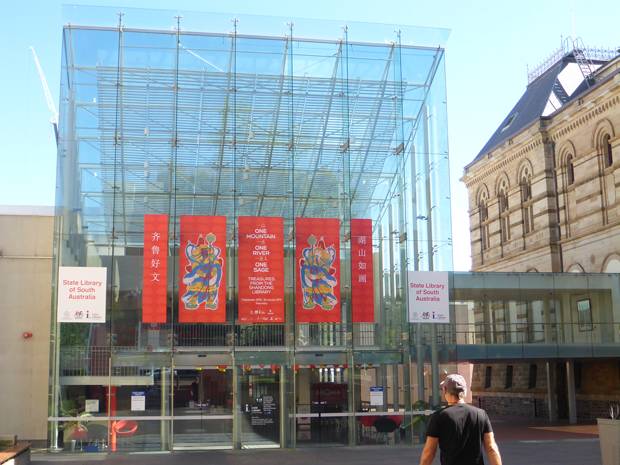

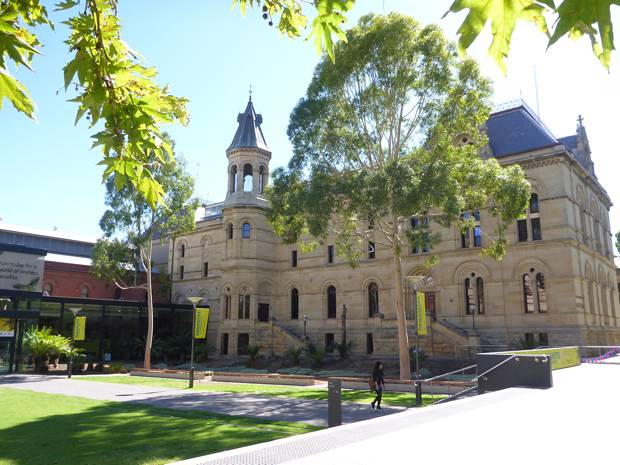
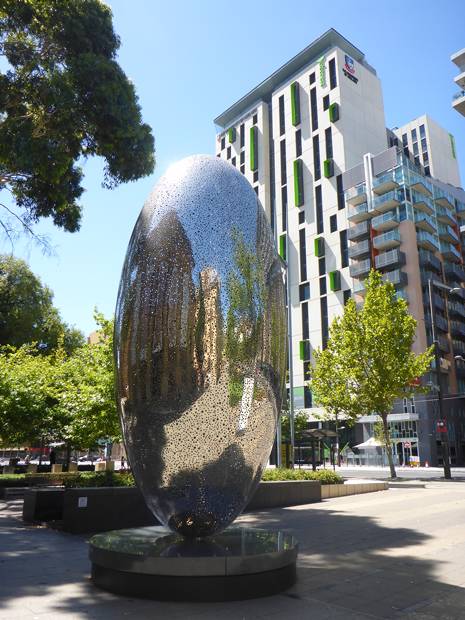
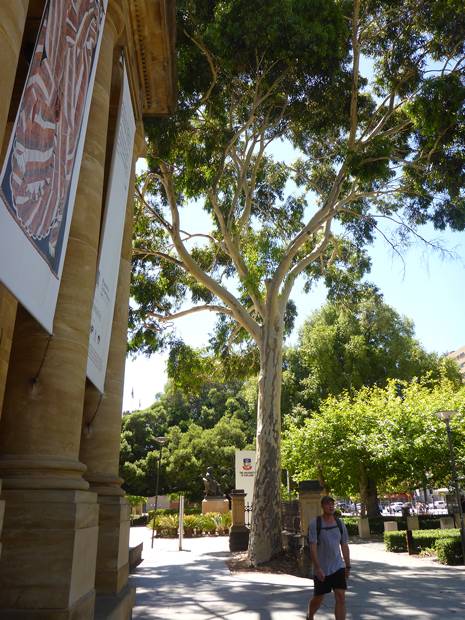
The feel of the area was just as one senses near the Natural History Museum, the Science Museum and the Victoria and Albert Museum in London. The benign lofty grandness of the buildings softened by green leafy trees on the outside while knowing there is so much knowledge and intelligence to explore inside. Somewhere to go and learn and appreciate the work of academics, intellectuals, researchers, explorers et al who have done and are doing what we will never do. And it’s all there for us to see and enjoy. Aren’t we lucky?
One Mountain One River one Sage
What do you think of the entrance foyer to the library? What really strikes me is its glass construction, visually open to the skies through its transparency and to all visitors, but not only that. Its connection to the skies links the library to all other parts of the world and to times past, the history and culture of the world up to the present time.
This is particularly relevant to the exhibition whose name I have borrowed for my blog. The library has strong cultural links to the Shandong Province and regional government in China and the story they are bringing to visitors is one of the past political ideals of not ruthless power over the people as in present day China but benevolent power used to protect and enlighten the people. Confucius in his philosophy and sayings teaches ordinary people how to live and be physically and mentally balanced and healthy.
I will let the photos tell the story. What is interesting and understandable is that no mention is made of modern day China and the stark contrast between the message of the past and the repressive regime of Communism ruling China today.
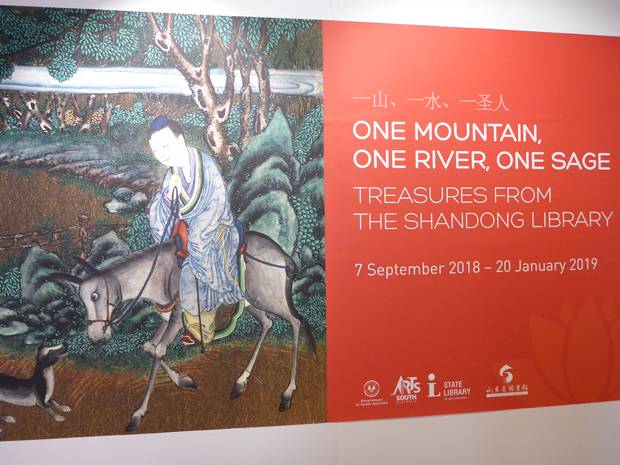
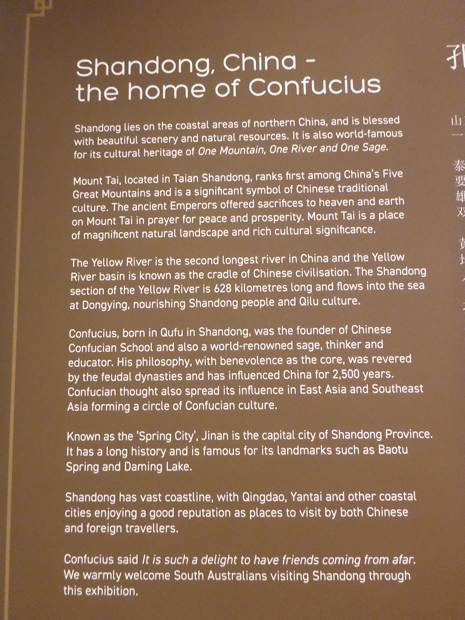
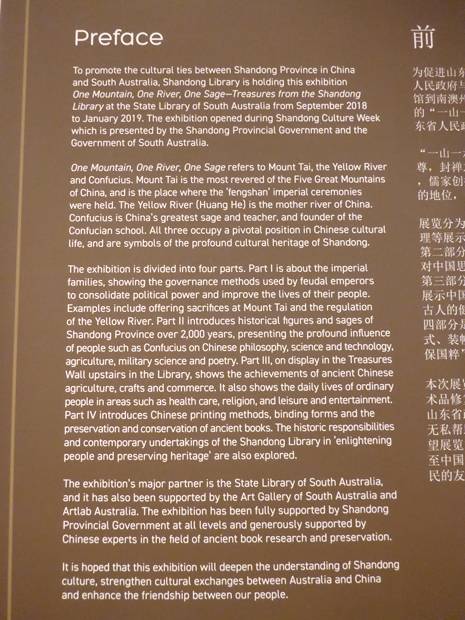
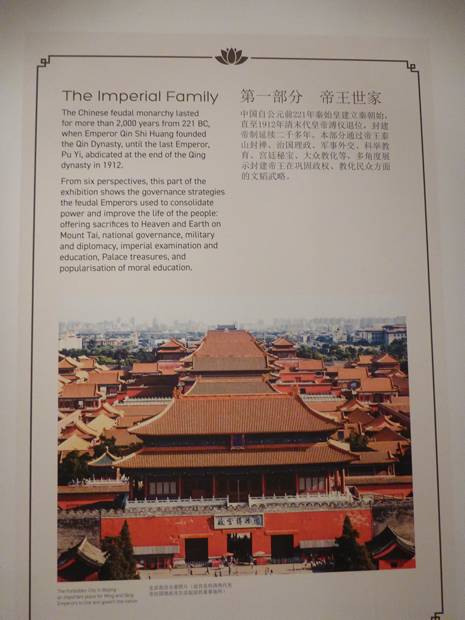
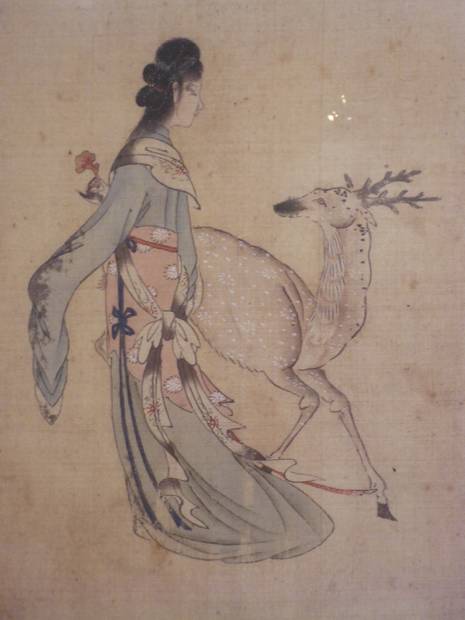
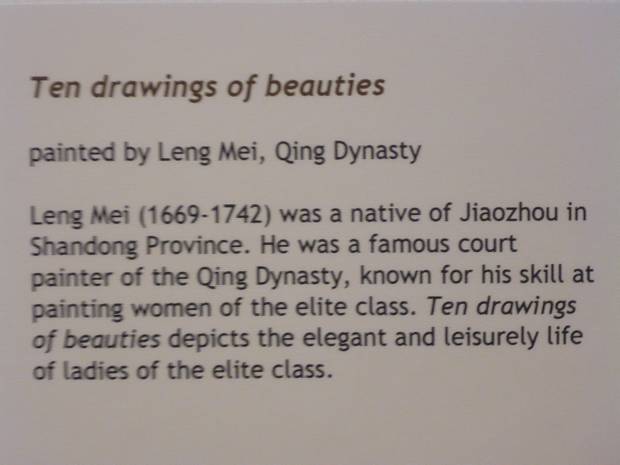
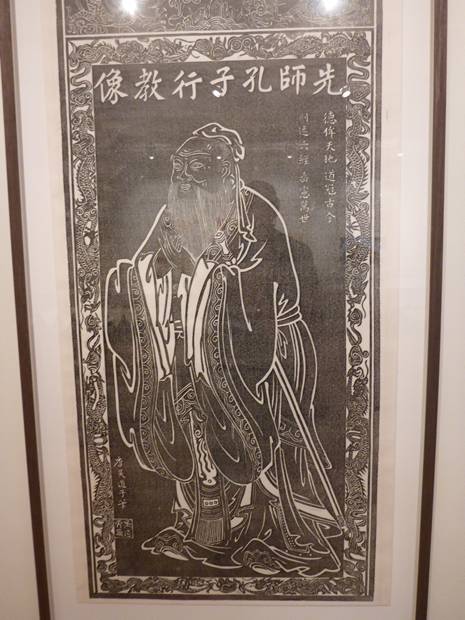
When we were outside the Visitor Centre at Regatta Point in Canberra it was a brave individual who has escaped his home country to tell the story on three shocking billboards. Falun Gong also known as Falun Dafa is an ancient Chinese philosophy the three central tenets of which are Truthfulness, Zhen, Compassion, Shan and Forbearance, Ren. Very Confucian don’t you think. This spiritual discipline for mind and body comprises moral teachings and five gentle exercises that are now practised by tens of millions of people all over the world, but according to the Chinese government it gives too much power to people to focus and control their own bodies and achieve individual strength.
Twenty years ago the then leader of the communist party launched a violent move to destroy it which continues unabated and in hideously large numbers.
People who have escaped China tell of whole generations of their families disappearing into internment camps never to be seen again. But the most shocking part was that these internees are reportedly killed to order and the sale of their body parts and organs is now a big source of revenue for the Chinese National government.
I read in a BBC investigation about and saw the images of Google Earth satellite photos which are proving that in once desolate empty areas of China many vast prison camps are being built to house these ‘political dissidents’.
It puts an interesting perspective on the exhibition and strongly suggests that at least some regional governments in China do not support the present regime. It is also good that the Chinese in Australia are free to spread the word about what is going on with their secretive government back home.
Again we had been lucky with our timing as that exhibition was also about to close. We wandered across to the Mortlock Chamber housing the Sir Josiah Symons Library built in 1884 as a museum and art gallery on the bottom floor and a library on the two upper floors.
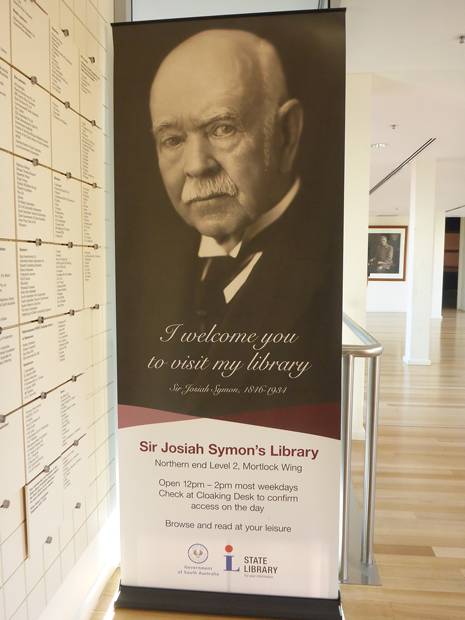
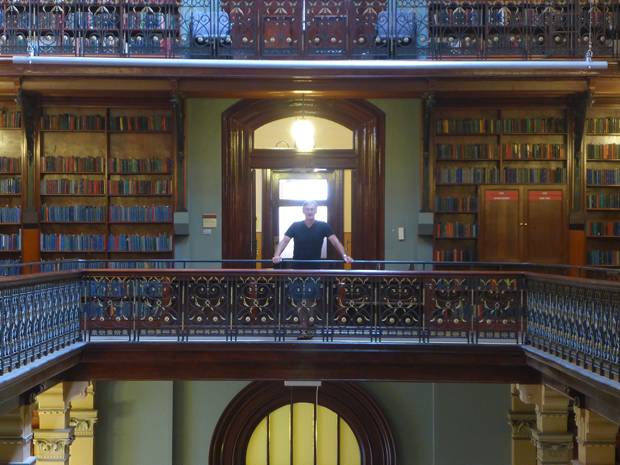
What struck me about these three beautiful buildings is that they all house masses of information, artefacts and images of the indigenous people. In the cultural history of Australia the story of the aborigines is understood in the academic world to be of immense importance and is shown with a respect and understanding that warms the heart.
The view down the length of the library from the second floor is stunning. The wrought iron work, golden lighting, symmetry and curves over the doors and in the atria combine to impress. Down each side there are shelves of books not only against the walls but also on little units at right angles to the walls creating discrete study areas in between each with its own wooden table and chair. When we strolled along the open side every study ‘hole’ was occupied by a person enjoying the peace and quiet and studious atmosphere. Many of the books were so old their original titles written on the spines had worn off. It looked as if the same careful hand had re-written the titles in white on thousands of books. What a job!
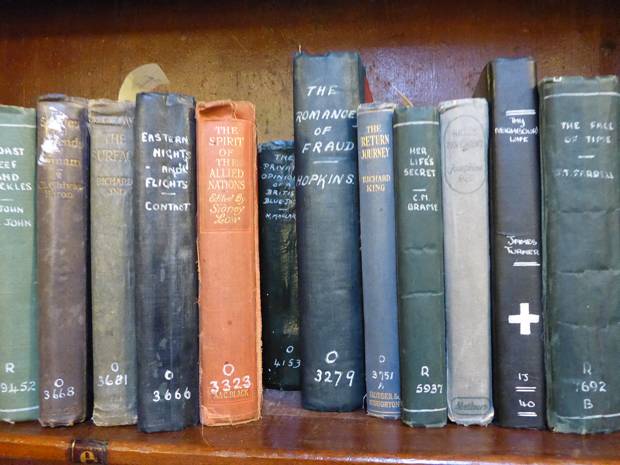
The day proved to be a real mixed bag of cultural enjoyment and a bit of a shock as we stood in the lift at the YH with a young girl. We got chatting about our travels and when we got to the part about heading to Darwin her parting shot was “Look out for those Abos”. I was sorry to hear such an obviously discriminatory view from a modern young mind, but as Rob says “Takes all sorts love.”
Aboriginal Life in ‘Country’
The views outside our YH at the start of this post are from the communal room and give an idea of just how pleasant Adelaide is. The Youth Hostels we use are always in the city centre, as we have no transport of our own apart from walking it makes life cheap, easy and enjoyable as we both love walking, although preferably not when we are nursing an injured back and a broken foot, (my recent x-ray showed my 5th metacarpal base on my left foot is mending well after the bike incident) and beggars can’t be choosers.
So that day our journey took us through a banadu (white man) city centre to the heart of Aboriginal life in ‘country’ as they like to call what we know as the outback. In the Aborigine view ‘country’ is a place to be shared, respected and cared for by everyone including us.
The South Australia Museum is a magnificent place full with fabulous exhibitions including: – The most ancient fossils from Reg Sprigg’s newly ratified (2004) Ediacaran period which spanned 94 million years up to the beginning of the Cambrian Period 540 million years ago and is named after the Ediacara Hills of South Australia, (thanks Mr Wikipedia, honestly every day’s a school day), Australian Polar Collections and megafauna and opal fossils.
Also a whole floor on South Australian biodiversity, one and a half floors on our bininj indigenous friends’ cultures, whales and dolphins flying high in the ceiling above and special exhibitions, a discovery centre and of course, Ancient Egyptian mummies and daddies. Wonderful place.
I would have liked to include more but because I have to keep a sense of balance in the blog I decided to concentrate on Aboriginal life as we were visiting their country.
The photo of the split tree shows an aged cut from which the tree has spent many years repairing its wound. From the examples we have seen in New Zealand, the islands and here we have learned that both the outer bark can be used for bark paintings and canoe making after it is carefully pealed from the tree. The inner part which has hardened nicely from exposure to the air can also be used for shallow canoes as well as shields and dishes.
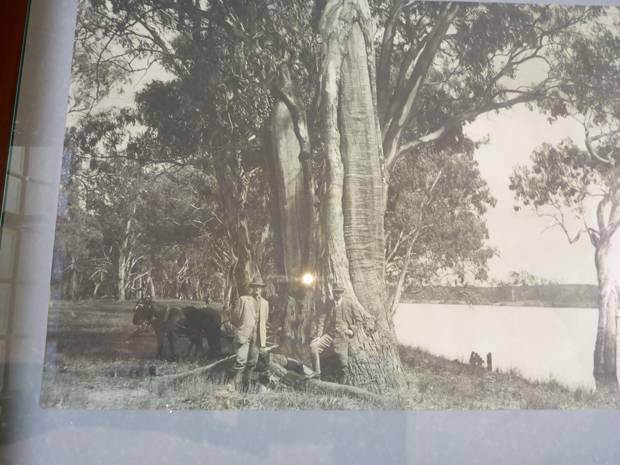
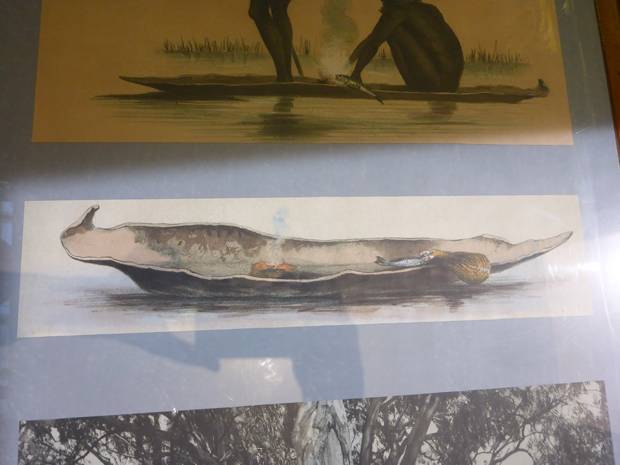
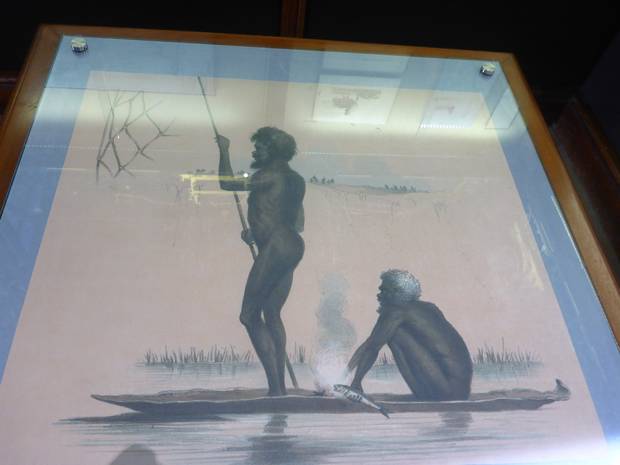

Many aborigines had dry homes underneath rock overhangs so the bark boards decorated with their paintings would be erected as an outer wall creating an enclosed area with rock paintings on one side and bark paintings on the other, all telling creation stories about the spirits from the ‘dreamtime’ as well as pictorial narratives of their own journeys through country.
Just as we have incorporated their artwork into our culture in the form of souvenirs, domestic artefacts and high art, the latter now a valuable part of the global art market, so the aborigines recognise the arrival of white man by extending their art surfaces and mediums to include car doors, school doors (as you will see in the photo) and the media, remember the Bush Mechanics.
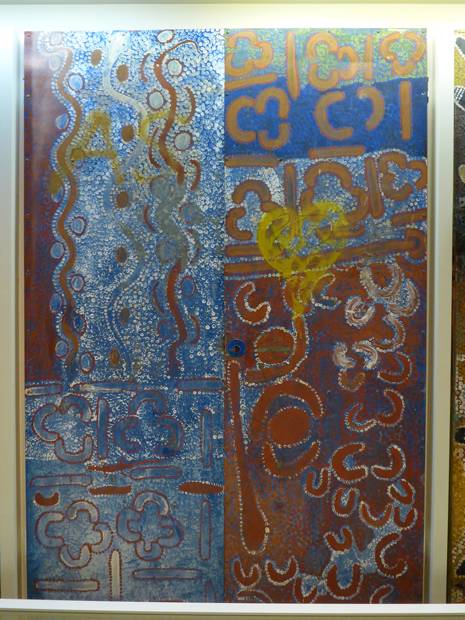
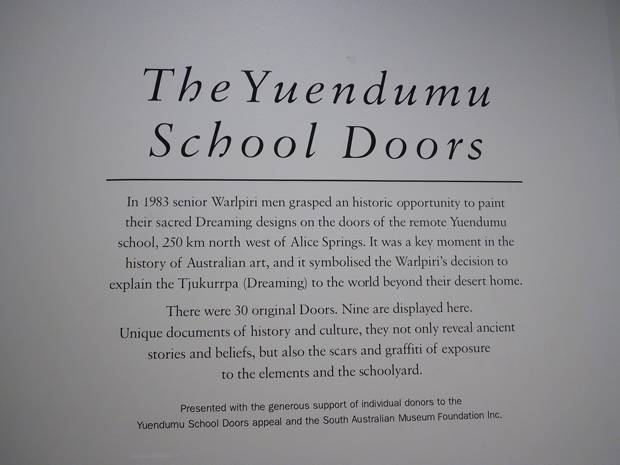
Years ago, and by co-incidence since it was long before we met, Rob and I both enjoyed an aboriginal art exhibition at the Hogarth Gallery in London where we first saw car doors and other white man’s junk, beautifully decorated with those familiar dots and curls.
It wasn’t just the variety of artefacts including spears, boomerangs, shields, baskets, woven bags, mats and clothing, fishing nets, jewellery etc. it was the sheer numbers of each. I wondered how the individual items were obtained and it seems most were gifted to or bought by explorers, missionaries, traders, academics and settlers with acquisitive and inquisitive minds and have been generously gifted or loaned to the museum.
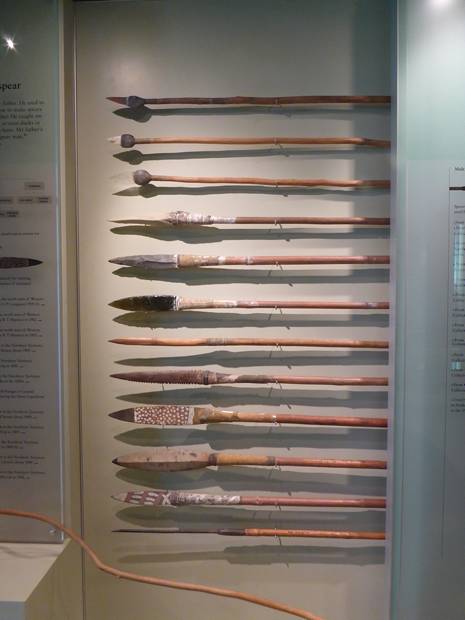

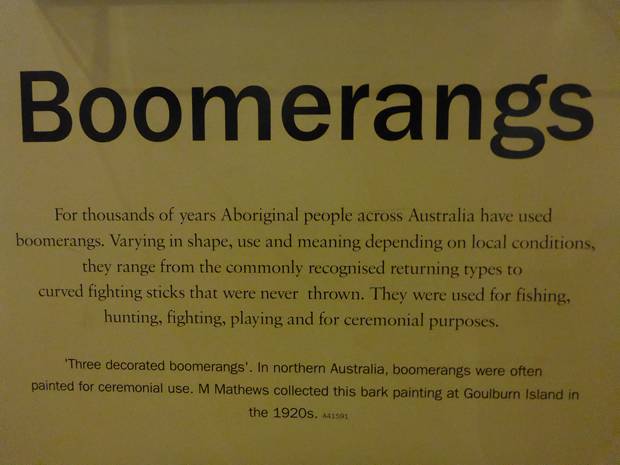

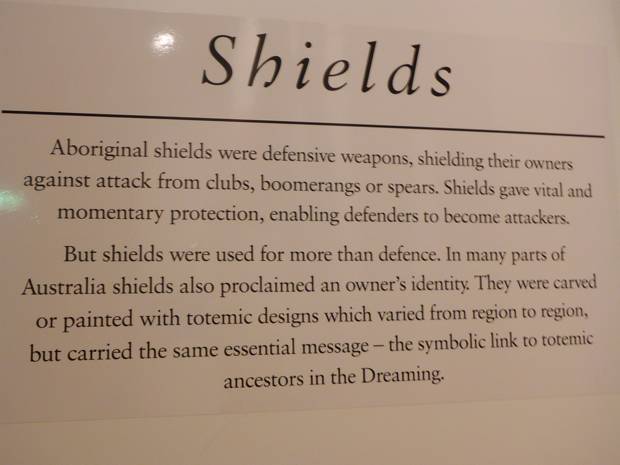
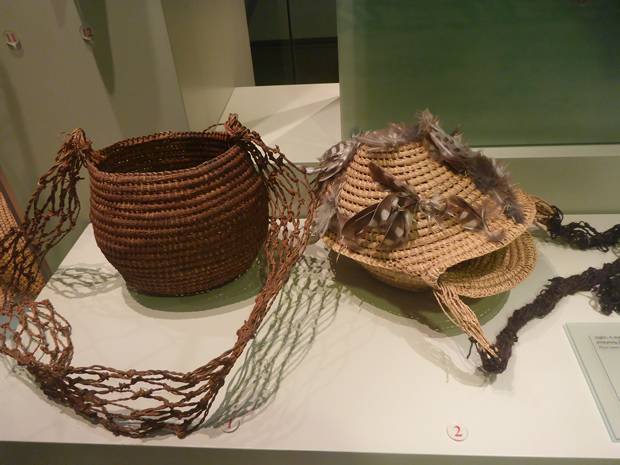
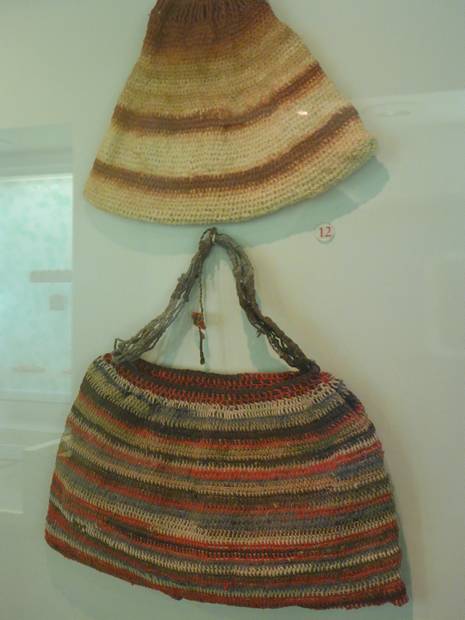
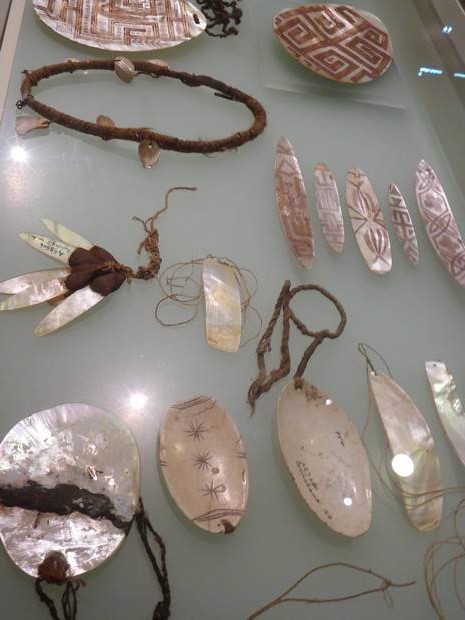
There were also vast collections of items showing the way of life of people from the Pacific Islands and Torres Strait, way too much to give due credit to here.
We didn’t visit the parasites exhibition but I thought you’d enjoy the advertising poster of the little dog having a good scratch. The mammals and birds stuffed and behind glass were a salutary reminder of the mass extinction we are passing through now. Some were still in existence in the world at the time of the mounting of the exhibits and many others have become extinct since.
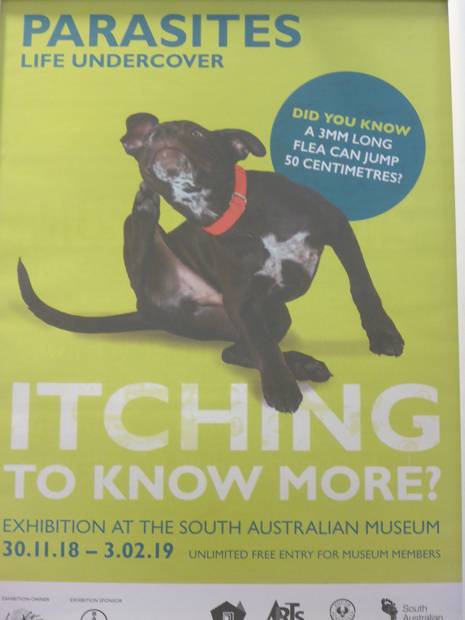
Take a look at the Tindale Map, what an achievement, not only in mapping the Aborigine clan areas but the fact that the map proved Australia is not Terra Nullius, a land without ownership, it belongs to its people as much as they belong to it. The map has proved invaluable in the numerous claims to land title and will continue to be a rich source of information for scientists and researchers in the future. I would love to know to what extent Tindale produced the map for those purposes and what was his original intention.
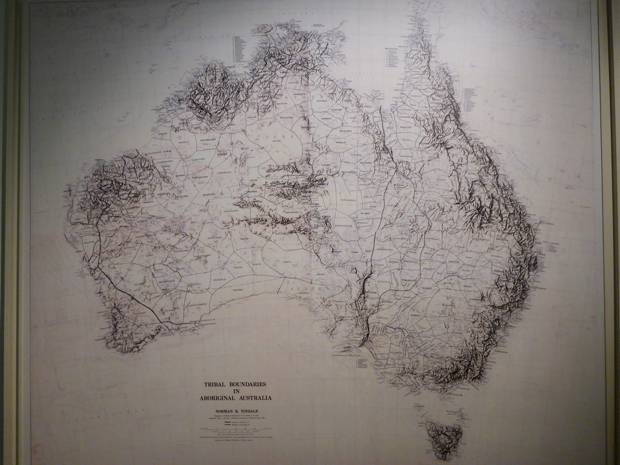
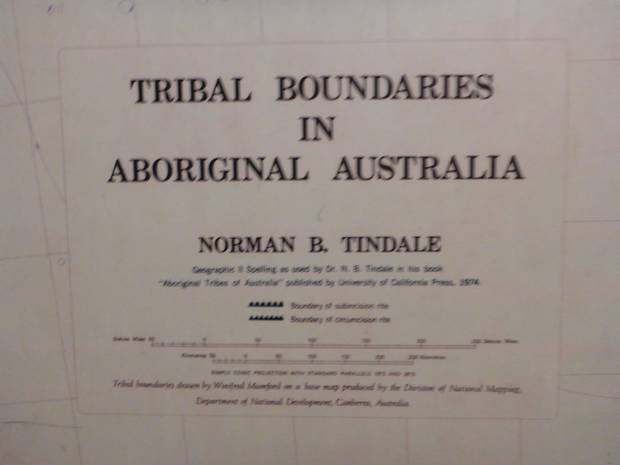
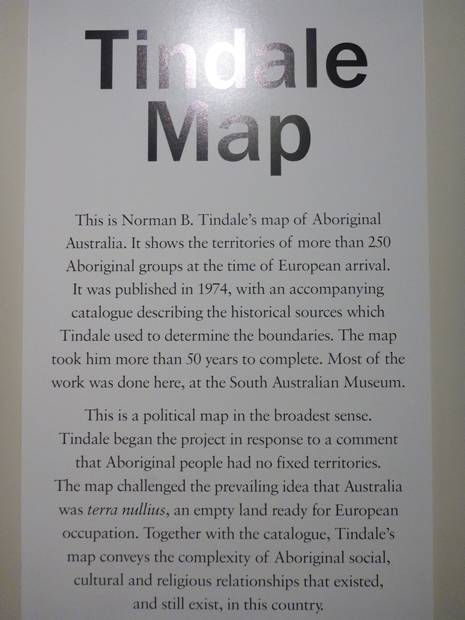
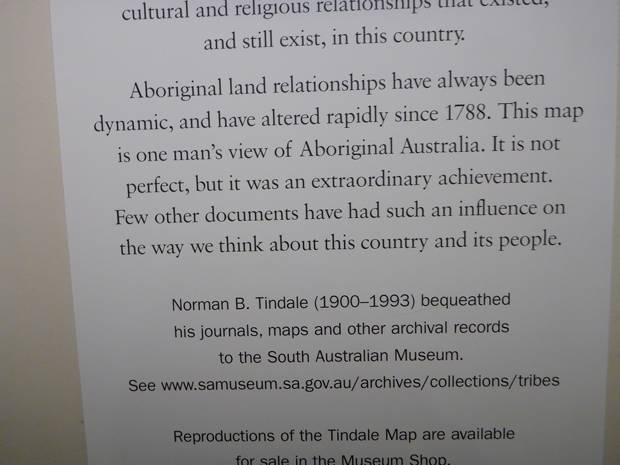
All that wealth of artefacts and information brought on quite an appetite so it was then time for lunch before we tackled the Art Gallery.
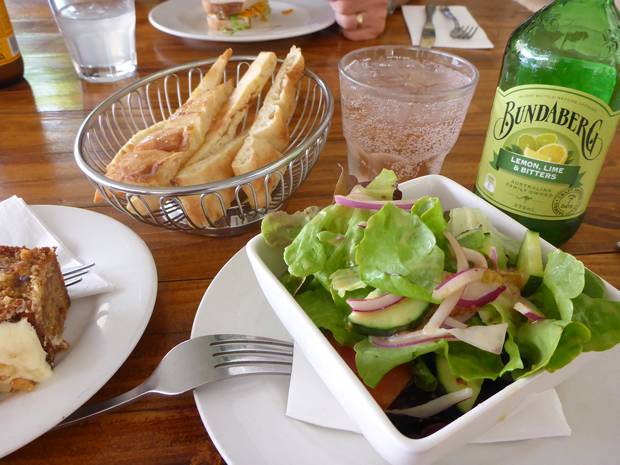
The Art Gallery of South Australia does just what it says on the tin
From soaking up the beautifully sunlit aura of the entrance to the Gallery with its fine classical colonnaded entrance to the smooth metal sculpture with clean modern high rises in the background to wandering around the galleries amongst the diverse exhibits I got the feeling this was an establishment that has a long history, 137 years in fact, the same length of existence as Rob’s family department store in Oakham.
Also this was no snobby high culture arena of elitist artworks, someone or group of people has brought art of the people to the people and that person was the previous art director, Nick Mitzevich who while he was working with the gallery doubled the annual footfall to over 800,000. I also got the decided impression that apart from his intelligent influence in the writing of the object descriptions for one thing, a woman or women were also at work. A woman’s touch in the form of the first female director, appointed only last year, Rhana Devenport who came from the Auckland Art Gallery and a country, New Zealand where there are many more ladies in such roles.
Part of The Gallery itself is built on Kaurna land and in the first paragraph of the welcome the gallery acknowledges and pays respect to these people as the traditional custodians of the land it stands on. There were small groups of bininj outside the gallery when we were there and some joined us on the same mission of enquiry.
There were so many things to like and to be amazed and shocked by. The cloisonné fish vase I thought was stunning. The depiction of the sulphur crested cockatoo in the painting and vase and the set of perfect cameos all depicting busts of aborigines were delightful. Some fine narrative paintings, the gathering of clans amongst high eucalyptus trees and the stockman on his horse trying to stop the stampeding sheep from trampling eachother at the billabong, I can see why that is a national treasure.
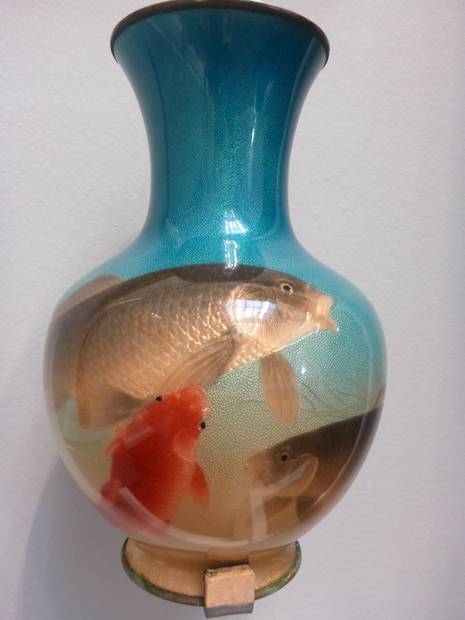
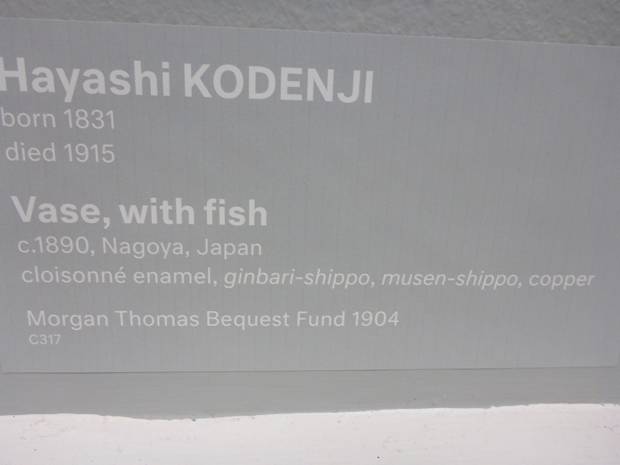
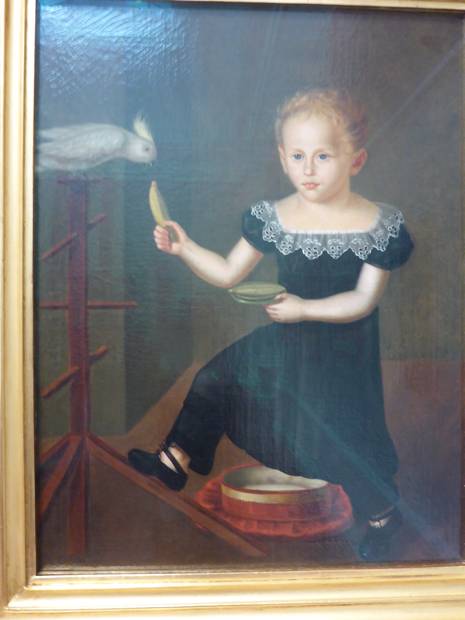
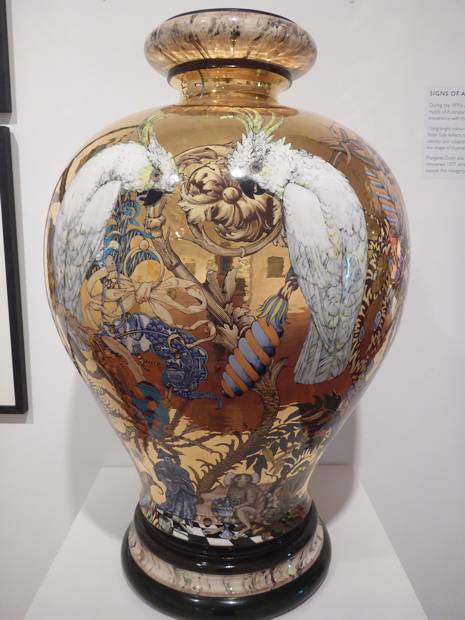
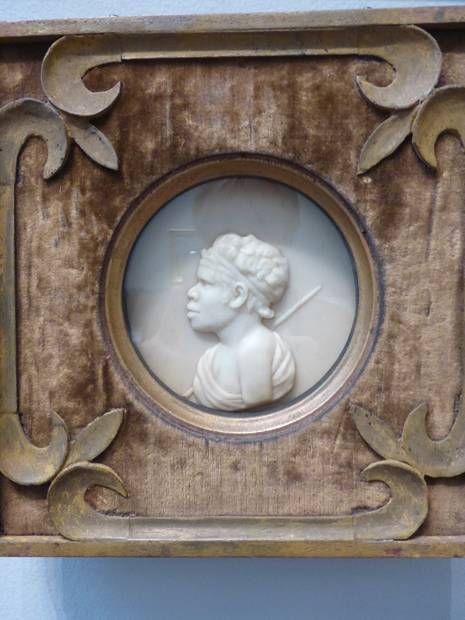
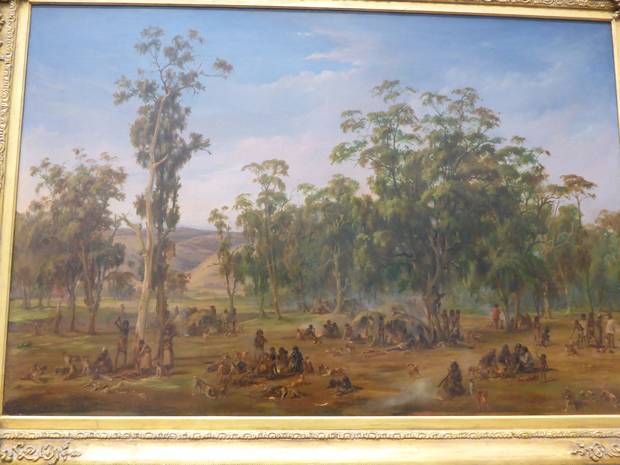
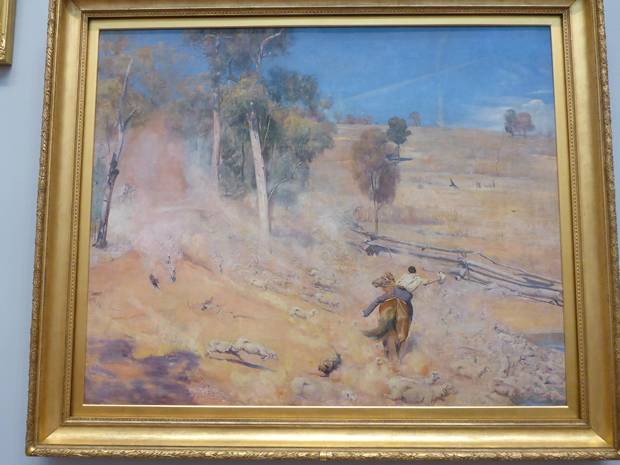
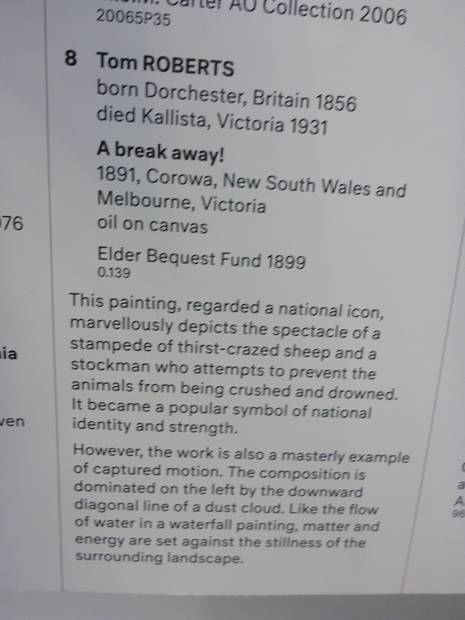
What do you think of the River Red Gum painted by West Arrernte artist and cameleer Albert Namatjura. He would have been more used to the traditional ‘pointillist style’ abstract art of his cultural history but how amazing is the rebirth of his style into landscape realism showing the extent of his skills and versatility. I actually snuck this one in also because of our up and coming trip on the Ghan and its connection to cameleer hauliers in railway construction, many of whom were aborigine.
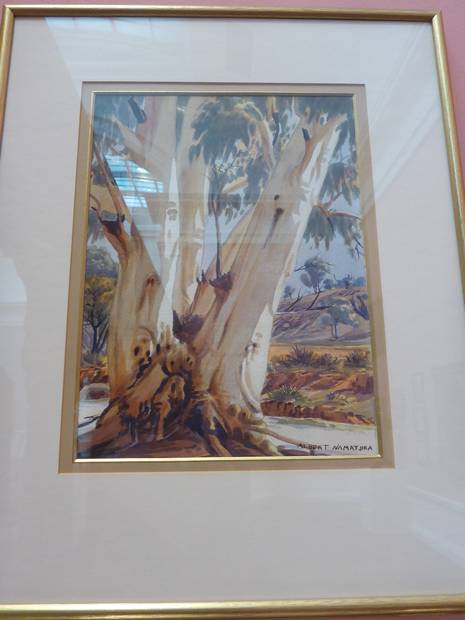
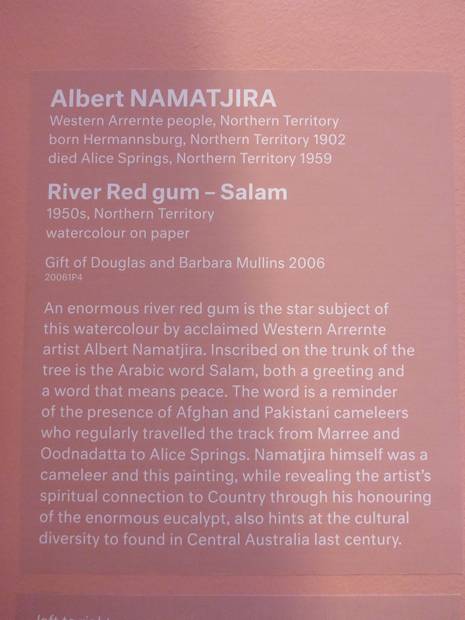
The transference of his artistic skills reminded me of how Picasso’s artistic style moved from realist and portrait to cubism, the other way around to Albert Namatjura and there was a lot about Picasso in the gallery too.
The brochure also mentions collections and displays that cross thousands of years of human history or maybe delves into the art of just one, as in my next blog. Also we found there art schools from the past, classical, impressionist, Raphaelite and Pre-Raphaelite to name a few but also modern and international. What about the red wool display Absence Embodied by Installation artist Chiharu Shiota?
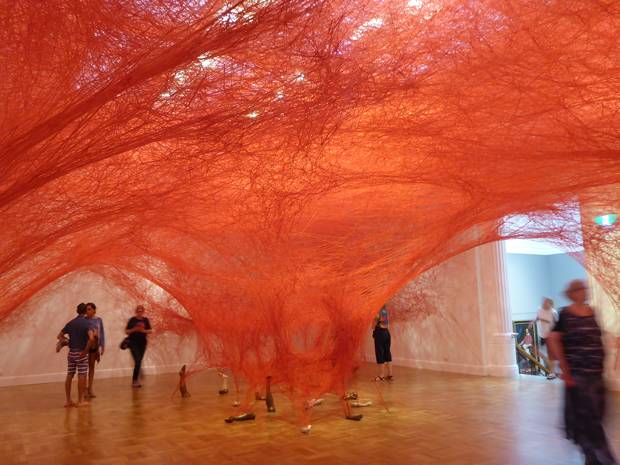
Standing in the corner of this room because that was the only place one could stand I felt a sense of journey, where space, filled with red wool was being drawn downwards to enable me to move onwards. That art form was a totally new one on me and I will explore it further another time.
Then for a shock, in a gallery whose walls were covered in comfortable, easy to appreciate artworks there was what appeared to be two horses locked together unnaturally, ‘We are all flesh’ by Belgian sculptur De Bruycker was quite alarming initially in its hints of trapped suffering, of two fine healthy bodies fused in pain. In fact it was an illusion as you can read, but it certainly provoked a definite response from the visitors as all good art should do. I wondered if the artist intended limiting the references of suffering to ‘Christian martyrdom’ or if those were the words of the interpreters and critics, there are so many other kinds of suffering in the world aren’t there.
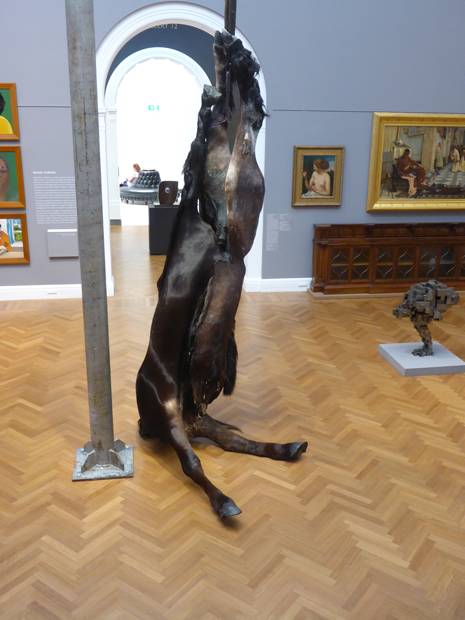
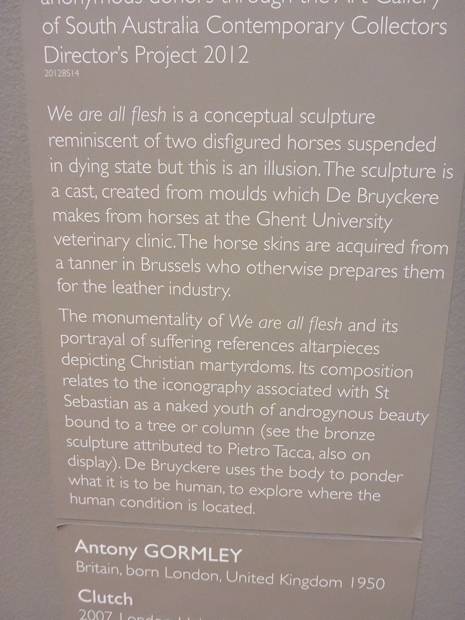
I liked the final sentence in the brochure, ‘We believe in the power of art to enrich the lives of all….’ Inclusivity and diversity, two good words in my view.
Portrait of an Artist John MawurndjulI ‘ I am the Old and the New’
The Art Gallery of South Australia, in particular the Collection and Exhibition Galleries on the Lower Level is where the ethos of John Mawurndjul and the collaboration between not only Bininj and Banadu but also men and women on the Gallery staff is epitomised in John’s fine and beautiful artwork. The photos hardly do justice to the delicacy of the brushwork. Sometimes brushes with just one hair are used and with such a steady hand the result has the intricacy of fine weaving, lacework and needlecraft.
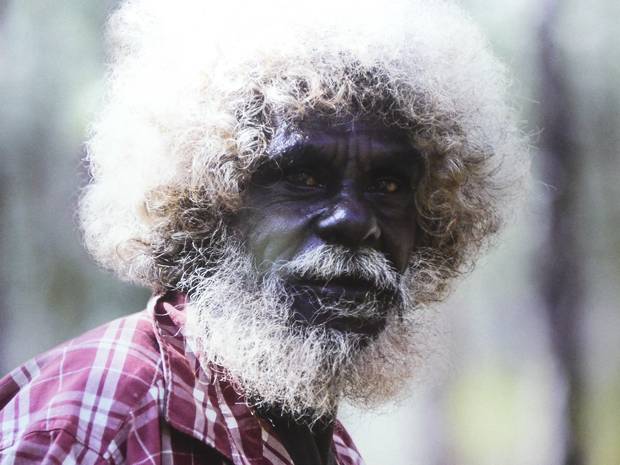
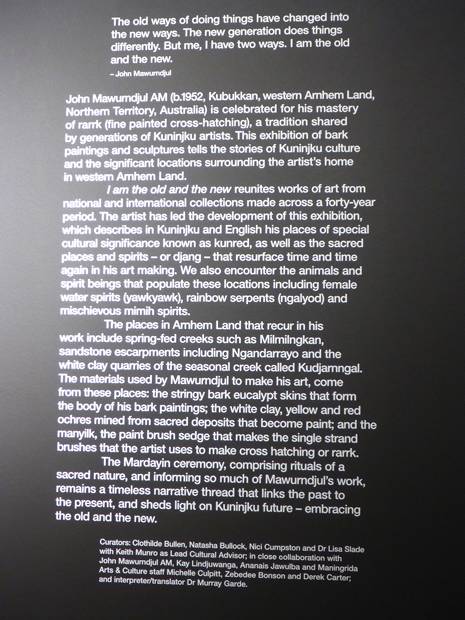
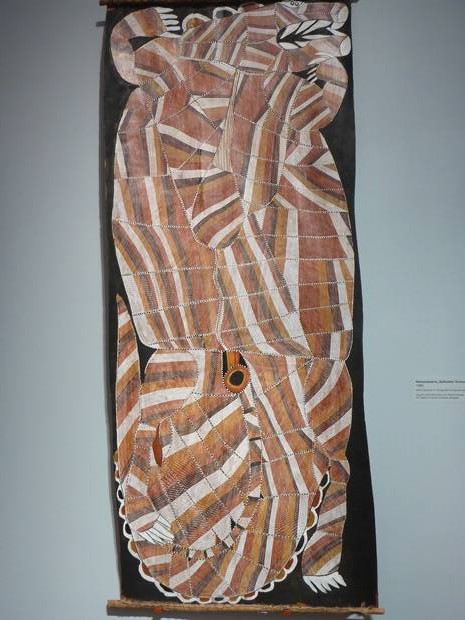
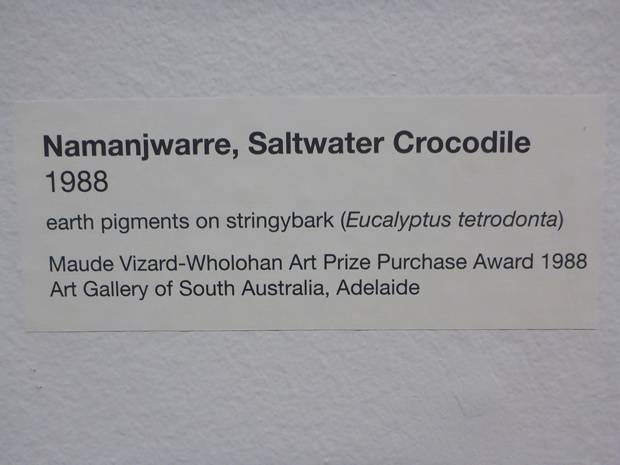
John led the exhibition team after deciding on the artworks he would display and just look at the list of gallery staff who assisted him. A clear display of the concept that if equality of cultures and genders works then use it as it certainly does here.
From the little time we had in Australia we saw that Bininj are really a valued part of the modern Australian art and culture scene but in politics and education, just as in New Zealand with the Maoris, they are on the outside looking in. The art that John uses to show the ways of the past preserves those beliefs and practices for history so the knowledge of them will not be lost even if they are no longer part of their way of life. He is like a conduit between the old and new cultures.
It was warming to see that the ancient cultural beliefs and ways of Aborigines spanning 65,000 years at the latest count in the form of the funeral customs and spirit world of the Dreamtime as shown here is being preserved and taken forward by people like John.
Dreamtime stories that have been told in the past are still being learned and enjoyed by new generations and are now spreading across cultures with the dissemination of published book versions to children from all over the world.
When we were at the Arboretum in Canberra with Tyronne we bought two of the Dreamtime stories told by his father, Ngunawal Elder Don Bell to read to our grandchildren here in the UK, ‘Dyirri the Frog’ and ‘Mununja the Butterfly’. One page in ‘Dyirri the Frog’ has a picture framed by two trees with multi coloured barks. Between them and next to a billabong (pond or lake permanently filled with water) sit a group of women resting from a day of food gathering for supper. I asked grand-daughter Ruby what she thought the colourful lines on the barks might represent. “Rainbows because it rains there and the sun is shining.” Next time we see Tyronne I will see what he thinks of her interpretation.
The aboriginal love of nature and the world of country is something children can really relate to.
When people die they are buried for some time or laid in a cleft in rocks or a cave and then their bones are placed in the tall tubes made from trees hollowed out by white ants. These moiety log coffins are finely decorated before being buried upright in the ground so the deceased can return to the spirit world. I am not sure if this is a current custom but the colourful tubes have certainly become part of the contemporary indigenous art world.
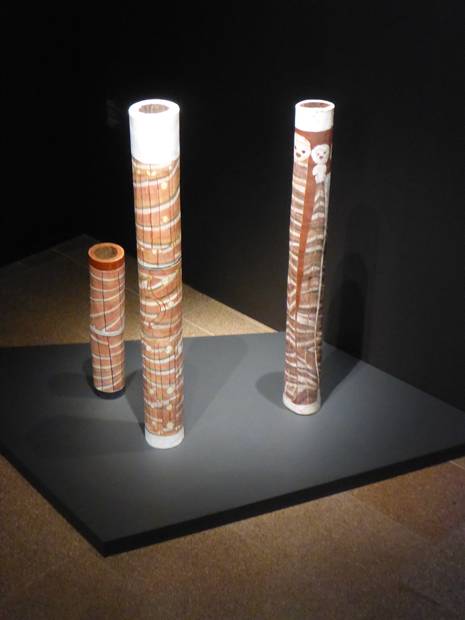
While we were absorbed in the gallery the temperature was rising outside. Australia was on the fifth day of the 10 hottest days on record. Noona had a night time temperature of 35.9’, Tarcoola reached 48.9’ in the day and Cobar’s Empire Hotel reached 50’ a few days ago. There are forest fires raging across Victoria, Tasmania and New South Wales causing extensive loss of flora and fauna. These fires travel so fast the animals have no chance of escape and firefighters risk their lives trying to save people and property.
When we finally left the Art Gallery we caught the free culture loop bus and did one and a half circuits to bring us back to the YH area. From there we walked to the highly acclaimed market only to find it had closed half an hour before. Never mind, a single dish supper in China town called for and after that we wandered slowly back to the YH via a bar. It looked very welcoming but the people were dressed unusually smartly. I sat on a bar stool and Rob was just about to order when a voice said over our shoulders “Have you been invited?”
“Oh no, we are so sorry are we gate-crashing?” A pretty young lady told us it was her engagement party and there was a sign outside saying ‘private function’. We apologised and wished her every happiness and yes there was a sign but it was much smaller than all the other signs and we missed it.
Back to our room to pack ready for our trip on the Ghan, we could hardly wait! Enough culture for now, we were ready for some country.
